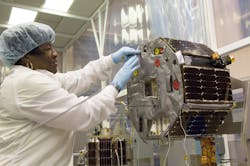Teledyne Acquires E2V Technologies in $789 Million Deal
Teledyne Technologies signed a deal Monday to acquire E2V Technologies, a maker of radio frequency parts and machine vision systems, for $789 million. Teledyne said that E2V’s technology would mesh with the mixed-signal and imaging products it sells to aerospace and defense firms.
The deal is the latest evidence of Teledyne’s sensitive trigger finger for acquiring new technologies and the engineers behind them to enhance growth. Teledyne, which acts like a holding company for around 70 different divisions, has focused in recently years on systems engineering, machine vision, and instrumentation in aerospace, defense, healthcare, and other markets.
E2v Technologies, which is based in Chelmsford, U.K., is known for making image sensors and power components for radio frequency applications in healthcare, factories, and wireless communications. It offers microprocessors and other chips for commercial airplanes, as well as assembly and packaging services for semiconductors. It has also builds satellite parts hardened against dangerous radiation.
In September, E2V released a new phase-locked loop that can be used in satellite control systems and based on novel silicon-on-insulator technology. Last month, it claimed to have built the first digital-to-analog converter that can generate K-band signals, which are harnessed for radar and satellite communications, without a mixer.
Teledyne said that these types of parts complement its microwave electronics and assemblies. “While we both provide microwave devices, e2v’s largest product and market are magnetrons for cancer radiotherapy,” said Robert Mehrabian, Teledyne’s chief executive, said in a statement. “Teledyne supplies solid state and vacuum microwave systems, but no magnetrons, and we primarily serve defense markets such as electronic warfare, radar and communications.”
E2V has also built radio systems for off-beat customers like law enforcement agencies. In 2013, the company disclosed that it was working on a system that projects radio pulses to remotely shut down the electronics in motorcycle and car engines. It creates a similar effect to an electromagnetic pulse at a distance up to 50 meters.
Neil Johnson, E2V’s chairman, said in a statement that the company would benefit from “being part of a larger, complementary group with enhanced scale and a wider range of capabilities to service its key customers and management.” E2V’s board of directors, he said, had approved the deal.
With previous deals, Teledyne has acted like a holding company, forming subsidiaries like Teledyne LeCroy, a maker of electronic test equipment, to operate independently. Neither company said whether E2V, which employs around 1,700, would become a subsidiary or be absorbed by other Teledyne units, like its Microwave or Microelectronic Technologies divisions. Over the last year, E2v had sales of around $340 million and netted about $60 million in profit.
The deal is expected to be completed in the first half of 2017.
About the Author

James Morra
Senior Editor
James Morra is the senior editor for Electronic Design, covering the semiconductor industry and new technology trends, with a focus on power electronics and power management. He also reports on the business behind electrical engineering, including the electronics supply chain. He joined Electronic Design in 2015 and is based in Chicago, Illinois.

